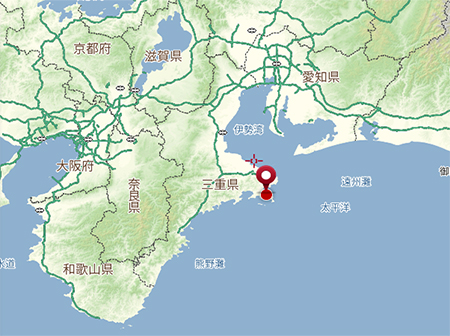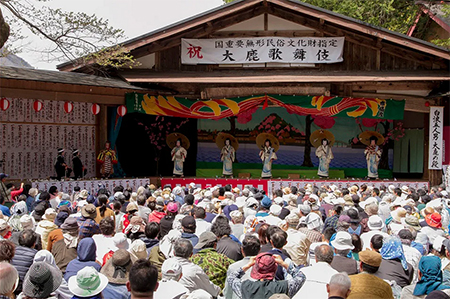

きのうまでの富山県五箇山の合掌造りから、
まっすぐに南下した地図位置の三重県の漁村「船越の舞台」。
住宅ではなく幕末期に創建の「舞台」です。
江戸期は封建の時代であり、各地域が経済的な発展を競っていた時代。
たとえば薩摩の密貿易など各藩の経済力が力強く勃興し、
現代からは想像できないほど「分権」的な経済発展があったと思える。
一方で幕府を運営する徳川氏は伝統的な農本主義の呪縛から
経済運営的には行き詰まっていたとされる。
勃興する市場経済に対して幕府はハンドリング能力を失っていた。
基本的な動因として経済運営の行き詰まりが政権交代を引き起こした。
この三重の太平洋側の漁村が属する志摩郡は江戸期の大名配置(変動)では
・九鬼家(5万5千石→5万6千石、1600年 – 1632年)。
➡摂津三田藩3万6千石・丹後綾部藩2万石へ転封
・内藤家(3万5千石、1632年 – 1680年)改易
・天領(1680年 – 1681年)
・土井利益(7万石、1681年 – 1691年)。肥前唐津藩7万石へ転封
・松平乗邑(6万石、1691年 – 1710年)。伊勢亀山藩6万石へ転封
・板倉重治(5万石、1710年 – 1717年)。伊勢亀山藩5万石へ転封
・松平光慈(7万石、1717年 – 1725年)。信濃松本藩6万石へ転封
・稲垣家(3万石、1725年 – 1871年)。
というような名前が記録に残っている。かなり変動が多い。
総じて外様から譜代へという藩の地域構成で混淆状態。
基本的には東海道要衝地域で江戸幕府系の支配地域だった。
この建物は1857年創建ということなので明治維新まであと11年という時期。
そういう時期に漁村ムラ社会でこういう舞台を建築している。

写真は現代の長野県大鹿での舞台風景。
このような光景が、幕末期に地図のような漁村で展開されていたのですね。
地芝居や買芝居を演じるためのこうした舞台は幕末期から
明治にかけて多く造られたのだとされています。
地域の「船越神社」祭礼は毎年旧6月14日で前後の13日から15日にかけ、
氏神様に芝居を奉納するのが慣例。そのため用意されたのがこの舞台。
現代でこういう舞台を自分たちの地域の力で建てるというのは、
公共事業ならば別として、民間活力では難しいだろうと思う。
この祭り期間が最大の活用期間ではあっただろうけれど、
この期間以外でもこの建物は活用されたに違いない。
こういった建築を作り上げる民の活発な経済活動が想起できる。
江戸では歌舞伎役者が大スターになっていた時代、
こういった鄙でも、その文化の一端が活発に展開していた。
建築と地域文化の「豊かさ」にクラクラとする思いであります。
English version⬇
[Luxury Noh stage in Edo period fishing village / Japanese good house ㉛-1]
From the gassho-zukuri of Gokayama, Toyama prefecture until yesterday
“Stage of Funakoshi”, a fishing village in Mie prefecture, located on a map that goes straight south.
It is not a house but a “Noh stage” built in the late Tokugawa period.
The Edo period was a feudal era, when each region was competing for economic development.
For example, the economic power of each clan, such as Satsuma’s smuggling, has risen strongly, and
It seems that there was a “decentralized” economic development that could not be imagined from the present day.
On the other hand, Mr. Tokugawa, who runs the shogunate, is from the traditional agrarian curse.
It is said that it was in a deadlock in terms of economic management.
The shogunate had lost its handling ability against the rising market economy.
As a basic motive, a deadlock in economic management caused a change of power.
Shima-gun, to which this Mie Pacific fishing village belongs, has a daimyo arrangement (variation) during the Edo period.
・ Kuki family (55,000 stones → 56,000 stones, 1600-1632).
➡ Transferred to 36,000 stones of the Sanda domain of Settsu and 20,000 stones of the Ayabe domain of Tango
・ Naito family (35,000 stones, 1632-1680)
・ Tenryo (1680-1681)
・ Doi profit (70,000 stones, 1681-1691). Transferred to 70,000 stones of the Hizen Karatsu domain
・ Matsudaira Norisato (60,000 stones, 1691-1710). Transferred to 60,000 stones of the Ise-Kameyama domain
・ Shigeharu Itakura (50,000 stones, 1710-1717). Transferred to 50,000 stones of the Ise-Kameyama domain
・ Matsudaira Mitsuchika (70,000 stones, 1717-1725). Transferred to Shinano Matsumoto Domain 60,000 stones
・ Inagaki family (30,000 stones, 1725-1871).
Such a name remains in the record. There is a lot of fluctuation.
As a whole, the clan’s regional composition is from the outside to the Fudai daimyō, and it is in a chaotic state.
Basically, it was a strategic area on the Tokaido and was controlled by the Edo Shogunate.
This building was built in 1857, so it’s about 11 years until the Meiji Restoration.
At that time, such a Noh stage is being built in the fishing village uneven society.
The photo shows a modern stage scene in Oshika, Akita Prefecture.
Such a scene was developed in a fishing village like a map at the end of the Edo period.
These stages for performing local plays and buying plays have been around since the end of the Edo period.
It is said that many were built during the Meiji era.
The local “Funakoshi Shrine” festival is held on June 14th every year from the 13th to the 15th before and after.
It is customary to dedicate a play to Ujigami. Therefore, this stage was prepared.
Building such a stage with the power of our own region in modern times is
Apart from public works projects, I think it will be difficult for private sector vitality.
This festival period would have been the maximum utilization period,
This building must have been used outside of this period.
We can recall the active economic activities of the people who make up such architecture.
In the era when Kabuki actors became big stars in Edo,
Even in this kind of country, a part of the culture was actively developing.
I am confused by the “richness” of architecture and culture.
Posted on 5月 18th, 2021 by 三木 奎吾
Filed under: 住宅マーケティング, 日本社会・文化研究







コメントを投稿
「※誹謗中傷や、悪意のある書き込み、営利目的などのコメントを防ぐために、投稿された全てのコメントは一時的に保留されますのでご了承ください。」
You must be logged in to post a comment.